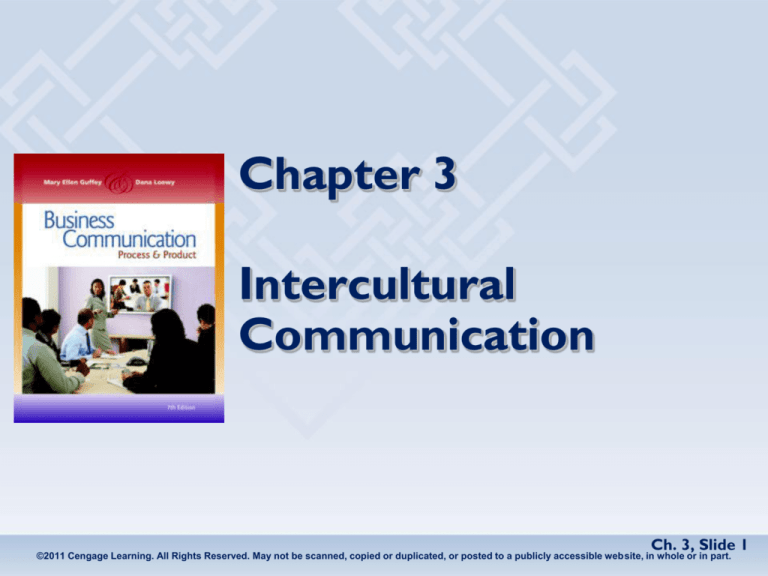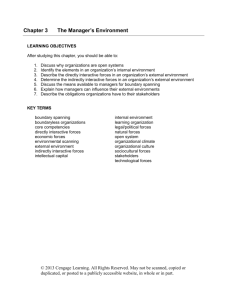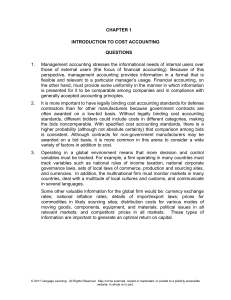
Chapter 3
Intercultural
Communication
Ch. 3, Slide 1
©2011 Cengage Learning. All Rights Reserved. May not be scanned, copied or duplicated, or posted to a publicly accessible website, in whole or in part.
Reasons for the Increasing Importance of
Intercultural Communication
The globalization of markets
Technological advancements
Global connectivity
An intercultural workforce
Ch. 3, Slide 2
©2011 Cengage Learning. All Rights Reserved. May not be scanned, copied or duplicated, or posted to a publicly accessible website, in whole or in part.
Globalization of Markets
Mergers,
acquisitions, and
buyouts stir growth
beyond national
boundaries.
American companies
in global markets
must adapt to other
cultures.
New trade
agreements, declining
domestic markets,
and middle-class
growth drive global
markets.
Ch. 3, Slide 3
©2011 Cengage Learning. All Rights Reserved. May not be scanned, copied or duplicated, or posted to a publicly accessible website, in whole or in part.
Technological Advancements and
Global Interconnectivity
The development of
new transportation
and information
technologies fuel the
explosive growth of
global markets.
The Internet and the
Web are changing
the way we live, the
way we do business,
and the way we
communicate.
Ch. 3, Slide 4
©2011 Cengage Learning. All Rights Reserved. May not be scanned, copied or duplicated, or posted to a publicly accessible website, in whole or in part.
Expanding Intercultural Workforce
Immigration makes
intercultural
communication
increasingly
necessary.
Business
communicators must
learn to adapt to an
intercultural
workforce and
multinational
companies.
Ch. 3, Slide 5
©2011 Cengage Learning. All Rights Reserved. May not be scanned, copied or duplicated, or posted to a publicly accessible website, in whole or in part.
Characteristics of Culture
Ch. 3, Slide 6
©2011 Cengage Learning. All Rights Reserved. May not be scanned, copied or duplicated, or posted to a publicly accessible website, in whole or in part.
Dimensions of Culture
Formality
Communication Style
Individualism
Context
Culture
Time
Orientation
Ch. 3, Slide 7
©2011 Cengage Learning. All Rights Reserved. May not be scanned, copied or duplicated, or posted to a publicly accessible website, in whole or in part.
Context
Low-context cultures
tend to be logical,
linear, and actionoriented.
Context
North America, Germany,
Scandinavia
High-context
cultures tend to be
relational, collectivist,
intuitive, and
contemplative.
Japan, China, Arab
countries
Ch. 3, Slide 8
©2011 Cengage Learning. All Rights Reserved. May not be scanned, copied or duplicated, or posted to a publicly accessible website, in whole or in part.
Individualism
High-context
cultures tend to
prefer group values,
duties, and decisions.
Low-context cultures
tend to prefer
individual initiative,
self-assertion, and
personal
achievement.
Individualism
Ch. 3, Slide 9
©2011 Cengage Learning. All Rights Reserved. May not be scanned, copied or duplicated, or posted to a publicly accessible website, in whole or in part.
Formality
Some cultures may
prefer greater
formality in dress,
speech, and social
interaction.
North Americans
place less emphasis
on tradition,
ceremony, and social
rules.
Formality
Ch. 3, Slide 10
©2011 Cengage Learning. All Rights Reserved. May not be scanned, copied or duplicated, or posted to a publicly accessible website, in whole or in part.
Communication Style
High-context
cultures rely on
nonverbal cues and
the total picture to
communicate.
Meanings are
embedded at many
sociocultural levels.
Low-context cultures
emphasize words,
directness, and
openness.
People tend to be
informal, impatient,
and literal.
Communication
Style
Ch. 3, Slide 11
©2011 Cengage Learning. All Rights Reserved. May not be scanned, copied or duplicated, or posted to a publicly accessible website, in whole or in part.
Time Orientation
Time is precious to
North Americans.
Time correlates with
productivity,
efficiency, and
money.
Time is seen as
unlimited and neverending in some
cultures.
South Americans
have a more relaxed
concept of time.
Time
Orientation
Ch. 3, Slide 12
©2011 Cengage Learning. All Rights Reserved. May not be scanned, copied or duplicated, or posted to a publicly accessible website, in whole or in part.
Characteristics of High-Context
and Low-Context Cultures
High Context
Japanese
High-context cultures are
relational, collectivist,
Arab
intuitive, and contemplative.
Latin American
Spanish
English
Italian
French
North American
Low-context cultures are
Scandinavian
logical, linear, individualistic,
German
and action-oriented.
Swiss
Low Context
Ch. 3, Slide 13
©2011 Cengage Learning. All Rights Reserved. May not be scanned, copied or duplicated, or posted to a publicly accessible website, in whole or in part.
How We Form Judgments
Stereotype
An oversimplified behavioral pattern applied
uncritically to groups
Ch. 3, Slide 14
©2011 Cengage Learning. All Rights Reserved. May not be scanned, copied or duplicated, or posted to a publicly accessible website, in whole or in part.
How We Form Judgments
Prototype
A mental representation based on
characteristics that are flexible and open to
new definitions
Ch. 3, Slide 15
©2011 Cengage Learning. All Rights Reserved. May not be scanned, copied or duplicated, or posted to a publicly accessible website, in whole or in part.
How We Form Judgments
Prejudice
A rigid attitude based on erroneous beliefs or
preconceptions
Ch. 3, Slide 16
©2011 Cengage Learning. All Rights Reserved. May not be scanned, copied or duplicated, or posted to a publicly accessible website, in whole or in part.
Techniques to Broaden
Your Intercultural Competence
Descriptiveness – giving descriptive feedback
instead of judgmental feedback
Nonjudgmentalism – being tolerant, which
helps prevent defensive reactions
Supportiveness – encouraging others with head
nods, eye contact, and facial expressions
Ch. 3, Slide 17
©2011 Cengage Learning. All Rights Reserved. May not be scanned, copied or duplicated, or posted to a publicly accessible website, in whole or in part.
Techniques for Bridging the
Gap Between Cultures
Tolerance – being open-minded and
empathetic
Helping others save face – raising their social
standing through positive comments
Patience – for example, letting others express
their thoughts without finishing their sentences
for them
Ch. 3, Slide 18
©2011 Cengage Learning. All Rights Reserved. May not be scanned, copied or duplicated, or posted to a publicly accessible website, in whole or in part.
How to Improve Communication
With Intercultural Audiences
Learn foreign phrases.
Use simple English.
Speak slowly and enunciate clearly.
Observe eye messages.
Encourage accurate feedback.
Ch. 3, Slide 19
©2011 Cengage Learning. All Rights Reserved. May not be scanned, copied or duplicated, or posted to a publicly accessible website, in whole or in part.
How to Improve Communication
With Intercultural Audiences
Check frequently for comprehension.
Accept blame.
Listen without interrupting.
Smile when appropriate.
Follow up in writing.
Ch. 3, Slide 20
©2011 Cengage Learning. All Rights Reserved. May not be scanned, copied or duplicated, or posted to a publicly accessible website, in whole or in part.
How to Improve Communication
With Intercultural Audiences
Consider local styles.
Observe titles and rank.
Use short sentences and short paragraphs.
Avoid ambiguous expressions.
Ch. 3, Slide 21
©2011 Cengage Learning. All Rights Reserved. May not be scanned, copied or duplicated, or posted to a publicly accessible website, in whole or in part.
How to Improve Communication
With Intercultural Audiences
Strive for clarity.
Use correct grammar.
Cite numbers carefully.
Accommodate readers in organization, tone,
and style.
Ch. 3, Slide 22
©2011 Cengage Learning. All Rights Reserved. May not be scanned, copied or duplicated, or posted to a publicly accessible website, in whole or in part.
END
Ch. 3, Slide 23
©2011 Cengage Learning. All Rights Reserved. May not be scanned, copied or duplicated, or posted to a publicly accessible website, in whole or in part.









